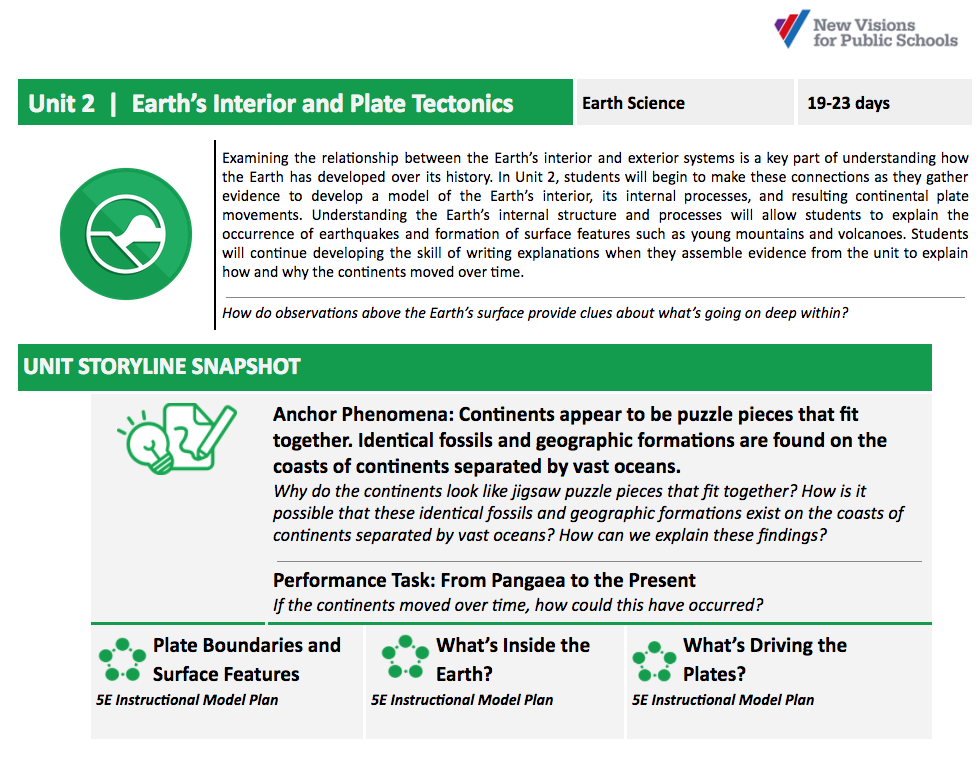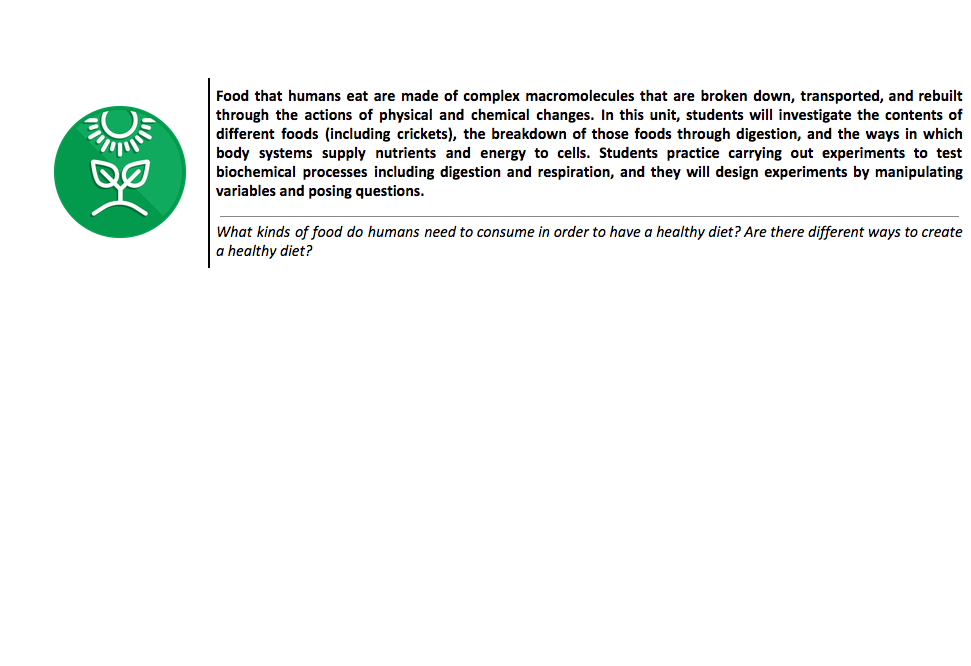- NV Science Team
- Professional Learning
- HS Biology
- HS Earth & Space
- Chemistry
- Physics
- Living Environment & Earth Science ARCHIVE
- LE Resources: LE Getting Started
- LE Unit 1: LE: Characteristics of Living Things
- LE Unit 2: LE: Nutrients, Energy, and Biochemical Processes
- LE Unit 3: LE: Homeostasis in Human Body Systems
- LE Unit 4: LE: Disease and Disruption of Homeostasis
- LE Unit 5: LE: Comparative Reproduction
- LE Unit 6: LE: Genetics, Biotech, and Decision-Making
- LE Unit 7: LE: Ecosystems and Invasive Species
- LE Unit 8: LE: Climate Change and Human Impact: Extinction vs. Evolution
- LE Regents Prep Resources: Living Environment Regents Prep Resources
- LE Data Tools: Living Environment Historical Regents Data
- ES Resources: ES: Getting Started
- ES Unit 1: ES: Origin of the Universe and Our Solar System
- ES Unit 2: ES: Earth's Interior and Plate Tectonics
- ES Unit 3: ES: Landscapes and Surface Processes
- ES Unit 4: ES: Geologic History and Evolution of Life
- ES Unit 5: ES: The Earth-Sun-Moon System
- ES Unit 6: ES: Weather
- ES Unit 7: ES: Geography, Climate, and Human Cities
- ES Unit 8: ES: Review of Major Topics
- ES Regents Prep Resources: Earth Science Review Modules
- ES Data Tools: Earth Science Historical Regents Data Tools
- Bulk Downloader Demo Video
Find Resources
Search and browse resources for your classroom.
Use the filters below to see resources for a specific course, unit, and more.
- Earth Science (NY State Core Curriculum, 2005) - Standard 4
Showing 25 Resources:
LE Unit 1: LE: Characteristics of Living Things
Living Environment & Earth Science ARCHIVE
LE Unit 1: LE: Characteristics of Living Things
Unit Overview: Characteristics of Life and Living Things Unit Plan
Discuss this resource
Please join the Disqus forum below to share questions, feedback, suggestions, or descriptions of your experience using this resource.
If you have found an error in this resource, let us know by submitting this form.
- LE Unit 1
LE: Characteristics of Living Things

Living Environment & Earth Science ARCHIVE
LE Unit 8: LE: Climate Change and Human Impact: Extinction vs. Evolution
Human population growth, globalization, and industrialization are having profound impacts on the long term health and stability of ecosystems, permanently altering the products of billions of years of evolutionary history on planet Earth. In this unit, students create plans to address the population decline of endangered species, gaining a greater understanding of how humans have altered ecosystems and what actions may be taken (including the use of biotechnology) to preserve biodiversity. Students create models and utilize simulations to gain a deeper understanding of large scale geological and biological processes.

Discuss this resource
Please join the Disqus forum below to share questions, feedback, suggestions, or descriptions of your experience using this resource.
If you have found an error in this resource, let us know by submitting this form.

Living Environment & Earth Science ARCHIVE
LE Unit 4: LE: Disease and Disruption of Homeostasis
Unit Overview: Disease & Disruption of Homeostasis Unit Plan
The incidence of disease at different point in history, and in different communities, is affected by lifestyle, access to healthy infrastructure, emerging pathogens, and new treatments. In this unit students will explore both the disappearance of certain diseases thanks to antibiotics and vaccines (strep and polio for example), and the emergence or growth of other diseases (such as asthma and diabetes). As a part of this unit, students may review cellular processes such as cell division. Accessing data from maps, graphs, and other non-print texts and using that data to draw conclusions and ask further questions is a key component to this unit.

Discuss this resource
Please join the Disqus forum below to share questions, feedback, suggestions, or descriptions of your experience using this resource.
If you have found an error in this resource, let us know by submitting this form.


Discuss this resource
Please join the Disqus forum below to share questions, feedback, suggestions, or descriptions of your experience using this resource.
If you have found an error in this resource, let us know by submitting this form.
- ES Unit 8
ES: Review of Major Topics

Examining the relationship between the Earth's interior and exterior systems is a key part of understanding how the Earth has developed over its history. In Unit 2, students will begin to make these connections as they gather evidence to develop a model of the Earth's interior, its internal processes, and resulting continental plate movements.

Discuss this resource
Please join the Disqus forum below to share questions, feedback, suggestions, or descriptions of your experience using this resource.
If you have found an error in this resource, let us know by submitting this form.

Energy flows and matter cycles among organisms, and between organisms and their environment, creating dynamic interconnected systems. In this unit, students learn about the biotic and abiotic factors in a river ecosystem, using the Hudson River as a case study. They then investigate the impact of an invasive species (zebra mussels) on this ecosystem, using teaching case materials created by scientists at the American Museum of Natural History.

Discuss this resource
Please join the Disqus forum below to share questions, feedback, suggestions, or descriptions of your experience using this resource.
If you have found an error in this resource, let us know by submitting this form.
- LE Unit 7
LE: Ecosystems and Invasive Species

Living Environment & Earth Science ARCHIVE
ES Unit 7: ES: Geography, Climate, and Human Cities
Unit Overview: Geography, Human Cities, and Climate Change Unit Plan
In this unit students will analyze and create topographic maps of human cities as they consider how geographical features such as oceans, lakes, and mountains have influenced where humans have chosen to live. Students will also make predictions about how changes in the Earth's surface features that may take place?whether due to climate change or other factors?can influence the migration of human populations in the future.

Discuss this resource
Please join the Disqus forum below to share questions, feedback, suggestions, or descriptions of your experience using this resource.
If you have found an error in this resource, let us know by submitting this form.

Humans are complex organisms that maintain a narrow set of internal conditions through a system of feedback and communication mechanisms between multiple organ systems. In this unit, students will explore how body systems interact to effectively monitor and respond to both internal and external environmental changes. Students complete both Making Connections (a New York State required lab) and a human thermoregulation laboratory, both of which focus on skills of experimental design.

Discuss this resource
Please join the Disqus forum below to share questions, feedback, suggestions, or descriptions of your experience using this resource.
If you have found an error in this resource, let us know by submitting this form.
Discuss this resource
Please join the Disqus forum below to share questions, feedback, suggestions, or descriptions of your experience using this resource.
If you have found an error in this resource, let us know by submitting this form.

As human populations grow and continue to migrate across the Earth, it is important that we use our understanding of why and how natural disasters take place to identify which populations are most at risk, so that measures can be taken to minimize loss of life and property. In this unit students will revisit tectonic plate boundaries when they observe and analyze earthquake activity data associated with a range of fault lines across the globe. Students will then evaluate the risk of various natural disasters in New York City and learn about effective emergency preparedness.

Discuss this resource
Please join the Disqus forum below to share questions, feedback, suggestions, or descriptions of your experience using this resource.
If you have found an error in this resource, let us know by submitting this form.

Living Environment & Earth Science ARCHIVE
LE Unit 2: LE: Nutrients, Energy, and Biochemical Processes
Unit Overview: Nutrients Energy & Biochemical Processes Unit Plan

Discuss this resource
Please join the Disqus forum below to share questions, feedback, suggestions, or descriptions of your experience using this resource.
If you have found an error in this resource, let us know by submitting this form.

Living Environment & Earth Science ARCHIVE
ES Unit 1: ES: Origin of the Universe and Our Solar System
Unit Overview: Origin of the Universe & Solar System Unit Plan

Discuss this resource
Please join the Disqus forum below to share questions, feedback, suggestions, or descriptions of your experience using this resource.
If you have found an error in this resource, let us know by submitting this form.